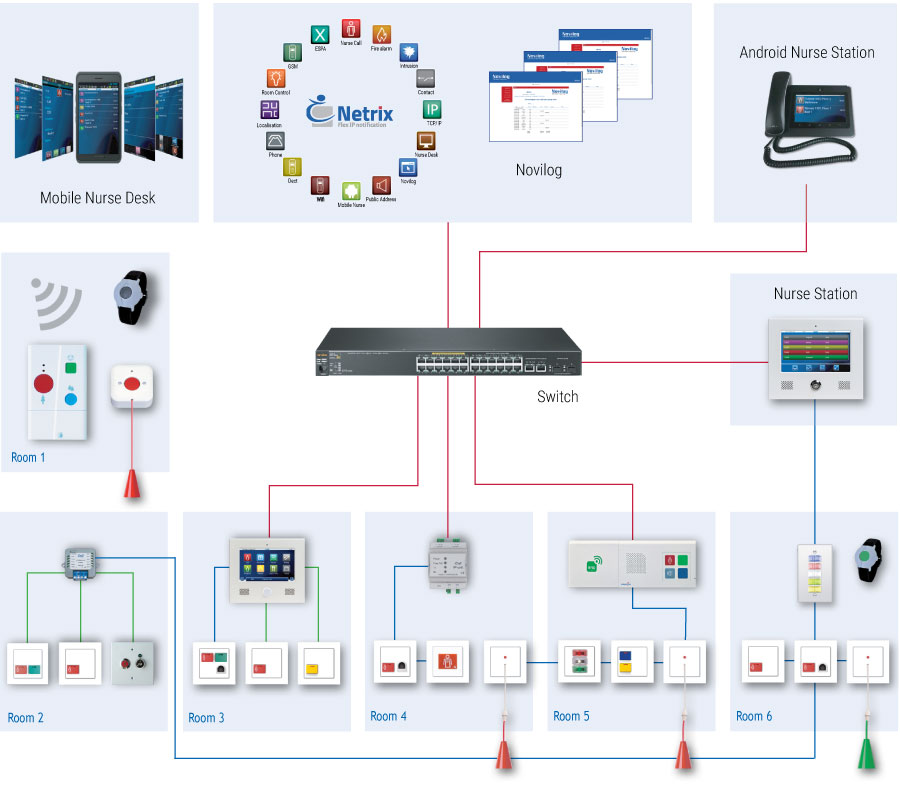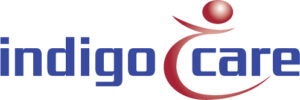SOS systems for emergency calls
SOS systems allow users, residents or visitors of different facilities to call for help when they need it. They are mainly used in hospitals, homes for the elderly, prisons, hotels and other public facilities, for example in toilets for the disabled.
Modern IP-based SOS systems enable much more than classic ones, and for their full functionality it is crucial to choose equipment that allows flexibility in adapting to business needs, ease of use and management, and which conforms to valid norms.

Advantages of IP-based SOS systems
IP-based SOS systems have numerous advantages compared to classic ones, both from the point of view of institutions that want or must have them and from the point of view of the users of their services (residents, patients, visitors). Already at the start of the investment, they are more profitable because it is possible to use existing systems, either by using existing conventional call points, or by taking over the old wiring of the facility via the BUS system (bridge to IP/TCP). They are also more flexible in terms of unlimited expandability and remote control, and can be integrated with other systems on the facility. Since SOS calls can be received not only via the computer in the control room, but also via mobile phones, they allow the staff to do their regular work without the users being uncertain does someone knows they need help.
- The possibility of using the wiring of the existing classic SOS system
- Unlimited possibility of system expansion
- Remote control
- Desktop and mobile application for receiving calls and communication with people in need – staff will receive a call for help even during performing regular duties, not strictly only in the control room
- Two-way voice communication between the staff and the person which made the SOS call
- Tracking the movement of persons with an SOS bracelet around the building and outside areas, position visible on the floor plan
- Checking each user’s care or treatment plan
- Entering data of taken measurements (weight, blood pressure, temperature), therapy and observations („meal eaten“)
- Automatic storage of all activities in the digital archive of events (call for help, assistance provided, resident measurements, visits). Possibility to view, export and analyze records.
- Identification of the person who provided help via ID card and reader
Elements of the SOS system
Central units
They enable reception, processing and storage of a call made through one of the calling units. The range of iCall central units allows a high level of flexibility, both in use and in system performance (high flexibility of integration). The use of the SIP protocol provides countless possibilities for communication inside and outside the facility (integration with VoIP telephony, intercom, etc).
Fixed and mobile call units
Call iCall units are available in several designs, from those that enable telephone calls, lighting and multimedia control, to those that respond to voice for people who cannot press the button (hands free). The various designs allow the use of existing, or inadequate wiring, which enables easy upgrade and modernization of old systems. All units are fully programmable.
A call for help can also be made via SOS bracelets, which, through precise geolocation technology, enable monitoring of the resident’s position at all times.
Signaling equipment
Signaling equipment includes different versions of opto-acoustic signalers for locating the microlocation of a call (room), room terminals with call repeating, and corridor displays for large facilities (hospital corridors). The equipment is also fully programmable.
Software for receiving and processing SOS calls
IndigoCare products are integrated with the IP “world” via the Netrix platform either via computers or smartphones. Integration of voice functions via the SIP protocol enables countless communication possibilities inside or outside the facility. Various software packages enable additional system functions, such as health monitoring, personnel data, schedules, evacuation modules, etc.
Additional equipment
Various network switches (PoE or non-PoE) are available. For the smooth operation of the system in case of power failure, the system must be treated as a safety system, and sufficient autonomy of the power supply should be ensured during design of the system.

Integration of the SOS system with other systems in the building
IP SOS systems can be integrated with other systems at the facility (video surveillance, access control, BMS). Due to user safety, the ability to integrate with the fire alarm system and related systems that enable safe and quick evacuation (evacuation public address system, panic lighting, smoke and heat extraction) is especially important. It is also possible to integrate using the ABSistemDCi integration software developed by Alarm Automatica.
Designing the SOS system
Designing is a key factor in the full functionality of the SOS system and that job should be entrusted to authorized persons. This avoids various improvisations, for example the use of a burglar alarm or fire alarm for SOS calls, situations in which the use of equipment from different manufacturers is impossible, and situations in which frequent maintenance is required, which makes the investment in the system expensive. When choosing equipment, care must be taken to ensure that it complies with the positive standards accepted in the European Union countries (VDE 834, BS8300) which prescribe the quality of SOS systems and equipment for specific purposes, for example for homes for the elderly and infirm or hospitals.
Indigo Care

Belgian company IndigoCare, part of the Essec Group, has been operating since 1977. and was the first in the world to produce a fully IP-based SOS system known today as iCall. They are one of the largest system integrators of emergency call, notification and telecommunications solutions in the world. The company operates in more than 48 countries and employs more than 130 people.
